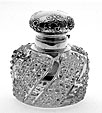Brilliant Era Glass Cutting House Catalogs - New England Glass Works 1884
 1884 Catalog Part A
1884 Catalog Part A
 1884 Catalog Part B
1884 Catalog Part B
 1884 Catalog Part C
1884 Catalog Part C
 1884 Catalog Part D
1884 Catalog Part D
 1884 Catalog Part E
1884 Catalog Part E
 1884 Catalog Part F
1884 Catalog Part F
 1884 Catalog Part G
1884 Catalog Part G
 1884 Catalog Part H
1884 Catalog Part H
 1884 Catalog Part I
1884 Catalog Part I
 1884 Catalog Part J
1884 Catalog Part J
 1884 Catalog Part K
1884 Catalog Part K
 1884 Catalog Part L
1884 Catalog Part L
 1884 Catalog Part M
1884 Catalog Part M
 1884 Catalog Part N
1884 Catalog Part N
 1884 Catalog Part O
1884 Catalog Part O
 1884 Catalog Part P
1884 Catalog Part P
 Index by Shape
Index by Shape
About the 1884 New England Glass Works Catalog
This online New England Glass Works catalog is based on a thin hardbound book produced in 1884. As can be clearly seen, the catalog date 1884 appears in tiny lettering on the title page artwork, just left of center. The covers are covered in gold-embossed red cloth with an unmarked spine, 10 ½” x 9 15/16”. The first three pages are printed and bound into the book. Each of the following twelve internal pages bears a large photographic print 11 ¾” x 9 ¾” which has been glued onto a blank stiff 10” x 9 ¾” page bound into the book. Each photograph shows four or five long strips of polished cut glass pieces, with pattern details sometimes obscured by glare. [Cut glass photography must have been quite challenging during those times!]
Each piece or group of pieces is identified by blank number in text beneath the corresponding photographic strip. No sizes and very few cutting pattern names are provided. Oddly, the most common shapes surviving into the 21st Century are not well represented in this catalog. There are many different low bowls and dishes, but very few taller bowls ((blank Nos. 108 through 111). Similarly, there are almost no flower vases: we see only the No. 113 flower globe in six different sizes. This catalog is especially important for identification of pieces cut in the earliest, simply composed patterns, because many of the shapes pictured in this catalog do not appear in any other surviving New England or Libbey documentation.
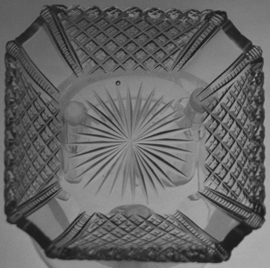
Octagonal (some might say cut cornered square) butter pat cut by the New England Glass Works on their blank No. 55. The pattern isn't named in the catalog, but motifs include crosscut diamond and prisms with a rayed star center. This design is probably Cut N pattern (see catalog p. 1) with a rayed star center to accommodate the blank shape, so could be called "Cut N with Rayed Star." 2 9/16" across. See NEW p. 7 upper row third from right.
Clearly, this is a hand-assembled catalog, one of very few that must have been prepared for distribution by a small and struggling firm. It might seem unlikely that this material was intended for use by distant customers, for there's insufficient information present with which to prepare an unambiguous written order (e.g., no sizes, no pattern designations, no costs). It might then follow that these books were carried by traveling salesmen to support presentations given to early customers. However, printed instructions on the verso of the title page ask recipients to subsequently paste in additional pages as they become available. This suggests that the catalogs were sent to distant customers and that the catalogs must have been prepared for that purpose by factory employees just beginning to learn how to design effective catalogs.
Provenance of this catalog is unknown, but the inside cover bears two bookplates indicating “Ex Libris Francis Waring Robinson,” and a sticker bearing a penciled notation “Lucy Cleary, Gales Ferry, CT.” Robinson was the Curator of. European Art at the Detroit Institute of Arts until he retired in 1977, having joined the staff of that Institute in 1939.
To maximize appreciation of the patterns documented in this rare old catalog, we have provided 2X magnification higher resolution page quadrant images that convey larger representations of the tiny pieces shown in each area of the pages in the original catalog. Quadrant sequence is {UL, LL, UR, LR}. Because the piece images are postage stamps, we've also posted higher resolution (400 dpi) page scans. For this catalog there are relatively few page images in each download, but the pattern detail is somewhat clearer.
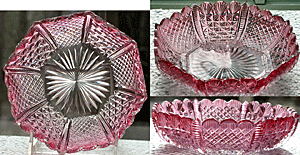
Three views of an octagonal flat bottomed low bowl in Cut N Pattern by New England Glass Works. See p. 2 row 3, #10, where this design is pictured on a finger bowl. Images provided by Warren and Teddie Biden.
During preparation of the online version of this catalog, we discovered some errors in the reprinting of the material, as it appears in the LABAC Cycle #14 NEW book.
a) The quarter page upper right quadrant for p. 3 was missing from the NEW book, but is included online.
b) The leftmost Spoon and Celery Glasses of each strip on catalog page five were cut off of the reprinted version (see NEW p. 5 vs. online “Part I”); these pieces are shown online as they appeared in the original catalog, resulting in ten items per row.
There are only a few named patterns mentioned in this catalog. Cut L, M, N, O and P patterns are named on the first catalog page, pictured cut on stemware. On page 2 more stemware is pictured cut in Hob Star or D pattern, Hobnail Diamond or D pattern, Strawberry Diamond or A pattern, Belgian or F pattern, and Russian or E pattern. These patterns appear on other shapes many times on subsequent pages, but they are not explicitly identified. It is evidently left for the reader to make the necessary pattern identification correlations.
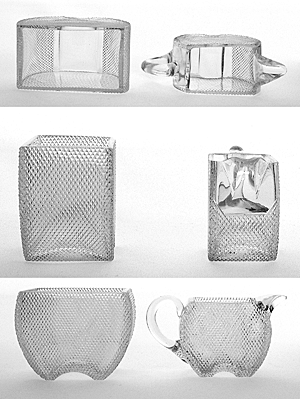
Three views of an unusual cream and sugar set cut in diamondpoint motif by New England Glass Works. The rectangular mold blown blank is No. 49, with bulging feet. Creamer 5 ¼” handle to spout, 1 7/8” wide, 2 7/8” tall; Sugar 4” long, 2 3/8” wide, 3 1/8” tall. Previously in the collection of Louise Swan. See p. 7 row 5, #3 for this exact set.
Obviously, the numbers appearing beneath each strip indicate blank or shape numbers, since in many strips we see adjacent examples of a single shape cut in different designs, but having the same number. We thus deduce that this catalog documents the very earliest New England/Libbey blank numbers, those ranging from No. 1 (stem) to No. 138 (larger lighting globe). Since identically-shaped pieces pictured in obviously varying sizes share a single blank number, we deduce that Libbey blank numbers of this era were shape or shape family numbers, rather than uncut item numbers.
This unusual old catalog has far more items pictured per page than most others. In fact, page 7 shows 65 different cut glass items made by the New England Glass Works, all on a single catalog page. Determination of pattern cutting features is challenging, based on the tiny "postage-stamp" sized images used. Full-screen examination of individual pieces under high magnification enabled preparation of detailed cutting pattern information, subsequently recorded in the index.
It has been extremely challenging to find surviving pieces pictured in this catalog, as few were seemingly made while the company was small and struggling. Very few of the items made seem to have survived, and not very many collectors seem able to identify those pieces. Perhaps widespread online access to this catalog will begin to improve that situation.
An earlier index for the New England 1884 catalog was prepared and edited during 2007 by Don Kosterman. That index has been revised and expanded for this presentation. Page numbers were reverted to those appearing in the catalog original. Shape names were changed to more clearly describe pictured forms. Pattern names were (whenever practical) revised to similarly reflect nomenclature found in factory catalogs and advertisements. Explicit pattern names were added whenever the patterns could be definitively identified. Several shape naming errors were corrected: the stem champagne was changed to saucer champagne; the whiskey was changed to champagne tumbler (obviously too tall for a shot glass); decanters were explicitly named; etc. Descriptive cutting details were added, based on high magnification examination of the page images. The augmented index was re-edited by Rob and Val Smith. Verification and quality control reviews of the resulting index were then done by Cindy and Price Chandler. We decided to publish the index in shape number order, since very few pattern names were defined.
Prior to the reappearance of this catalog, no New England Glass Works catalogs had been previously reprinted, and we know of no advertisements picturing New England cut glass products. There is one old (circa 1888) catalog archived at the Rakow Research Library showing New England Glass Works items. See microfiche f-63C. This online catalog differs significantly from that source.
We thought that it would be interesting to determine of which of the 1884 New England cutting blanks remained in production and for sale at the time of the reprinted 1896 Libbey catalog. Comparison of the two documents revealed that the No. 36 Ice Cream Plate of 1884 was still being made and cut in 1896. Similarly, the Nos. 35 and 38 nappy blanks, the No. 40 (corset form Spoon/Celery) and No. 42 (Spoon Tray) remained in production until after 1896. Likewise, the No. 69 (Oil Bottle) 128 (Sugar and Cream), 65 (Comport), 66 (Butter and Cover), 113 (Flower Globe), 81 (Jug), 84 (Champagne Jug) 133 (Jug) 112 (Ice Tub), and No. 90 (Decanter) were produced from at least 1884 until after 1896.
It would be challenging but worthwhile to document surviving examples of some of the unusual earliest New England Glass Works blanks. Several of the blanks shown here are especially noteworthy. For example, the “leaning octahedron” No. 48 Sugar and Cream blanks are very seldom seen. Similarly, the No. 49 rectangular Sugar and Cream with bulged feet are extremely rare forms.
An interesting future area of investigation and research related to this catalog would be determination of which (if any) of the 1884 New England cutting blanks remained in production at the time of the undated original Libbey blanks catalog found by LABAC and posted elsewhere on the ACGA website.
More generally, it would be worthwhile to determine when (as closely as practical) Libbey introduced and made each of its numbered blanks. This could be done by using dated catalogs and advertisements to figure out the earliest and latest appearances in factory documentation of each numbered shape. This data sorted by blank number would support a preliminary production dates span for each of the Libbey blanks.
Another issue deserving further research relates to the seemingly Russian-like Belgian pattern. Careful examination of magnified images from this catalog suggest that Belgian was a button-less design that superficially resembles Russian and MacDonald. It would be worthwhile to examine and photograph surviving pieces cut in the Belgian pattern documented here!
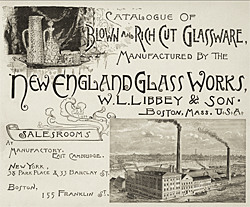
A Brief History of the
New England Glass Works
The New England Glass Works was established in 1818 at East Cambridge, MA (now part of the Boston metropolitan area) by Deming Jarvis and three partners. Jarvis acted as the plant general manager for the first seven years. The factory was ¾ mile from the old Revolutionary War Bunker Hill monument.
In 1872 William L. Libbey became the fourth and last “Agent” (General Manager) of New England Glass Company. The firm survived the Great Depression of 1873 but operated at a loss until the factory was leased to Libbey in 1878.
Edward Libbey (son of W. L. Libbey) became a partner in 1880, and the firm name changed to “New England Glass Works, W. L. Libbey and Son, Proprietors.” Edward Libbey became a productive salesman, able to promote the New England glass lines in the face of competition from cheaper Pittsburg glass firms making lime glass products. When his father died in 1883, 29 year old Edward Libbey assumed control of the factory, which was at that time in serious financial trouble. The present cut glass catalog was published soon after Edward Libbey began his 37 years of active management of the Libbey Glass interests.
Adverse economic factors (primarily freight costs for long distance coal fuel shipments and rising costs of unionized factory labor) caused Libbey to move factory operations to Toledo, Ohio during 1888. In that area, natural gas fuel was then abundant and cheap. Toledo provided free land for the relocating glass factory and worker housing as incentives to bringing in the initial 250 glassworking jobs. Just prior to the move, Libbey incorporated in Ohio on April 14, 1888 as the W. L. Libbey and Son Company.
The new factory lost money during early operations, then was able to take up a large and profitable light bulb blowing contract when a Corning glassworkers strike cut off the supply of bulbs needed by Edison General Electric. From 1889 until 1920, the average annual return on shares of the Libbey Glass Co was an astounding 138% of par value per year. Various successful glass-related businesses enabled Edward Libbey to became a very wealthy man.
The 1884 New England Glass Works Catalog was reprinted in Brilliant Cut Glass Catalogs, New England Glass Works 1884, Wilcox, Standard Engraving & Cut Glass 1916, Pitkin & Brooks 1917, T. B. Clark & Co. 1912, 424 pp., ISBN 978-0-937508-19-4, co-editors Val and Rob Smith, V-R Information Systems, 2008. ISBN 978-0-937508-34-3.
Rob Smith
January, 2014




